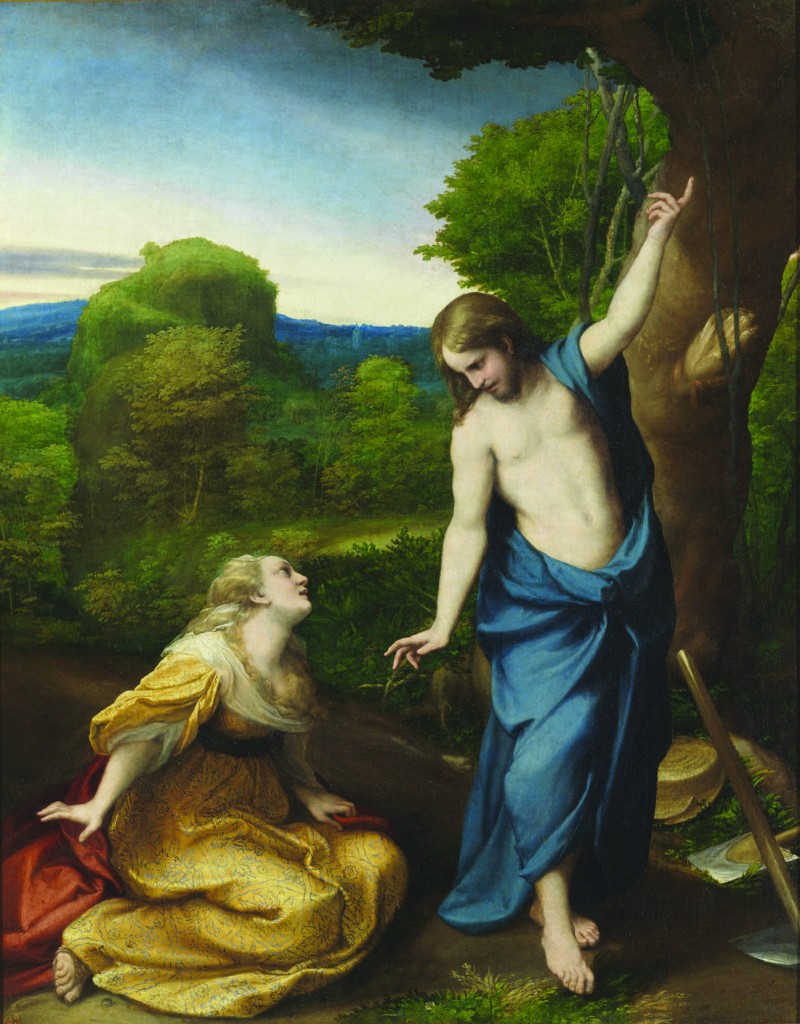
Correggio’s “Noli Me Tangere” in the Prado
Art in Parma in the 16th Century
For the general exhibition-going public, Italian Renaissance art — and especially the art of the 16th century — tends to revolve around three great centers: Florence, Venice, and Rome. Instead, “Correggio and Parmigianino” — on at Rome’s Scuderie until June 26th — aims to celebrate a remarkable yet little-known fact. For a few decades in the first half of the 16th century, the sheer quality of the finest paintings and drawings both produced in Parma and by artists from Parma working elsewhere, made Parma more than a match for any of its three rivals.
In essence, the reason for Parma’s brief golden age are its two leading lights: Antonio Allegri, known as Correggio (1489?-1534) and Francesco Mazzola, known as Parmigianino (1503-1540) or “the little one from Parma” because he was so precocious.
The son of a merchant, Correggio, born in the small, not faraway town of Correggio near Reggio Emilio (hence his nickname), did not arrive in Parma until the late 1510s. By this time he was already a highly-accomplished artist at the height of his career, and he remained based in the city for the rest of his life.
Curator David Ekserdjian, professor of art history at the University of Leicester, selected some 20 of Correggio’s paintings, covering the latter’s entire career, to underscore not only the extraordinary emotional power and expressive range of Correggio’s religious images, but also of his mythologies. These would have enormous influence on later artists from the Carracci brothers via Watteau to Picasso. Correggio’s unquestioned masterpieces on display include The Barrymore Madonna on loan from the National Gallery of Art in Washington D.C., the Portrait of a Lady from The Hermitage, The Martyrdom of Four Saints from the Galleria Nazionale in Parma, the Noli Me Tangere from the Prado, The School of Love from the National Gallery in London, and the Danäe from Rome’s Galleria Borghese.
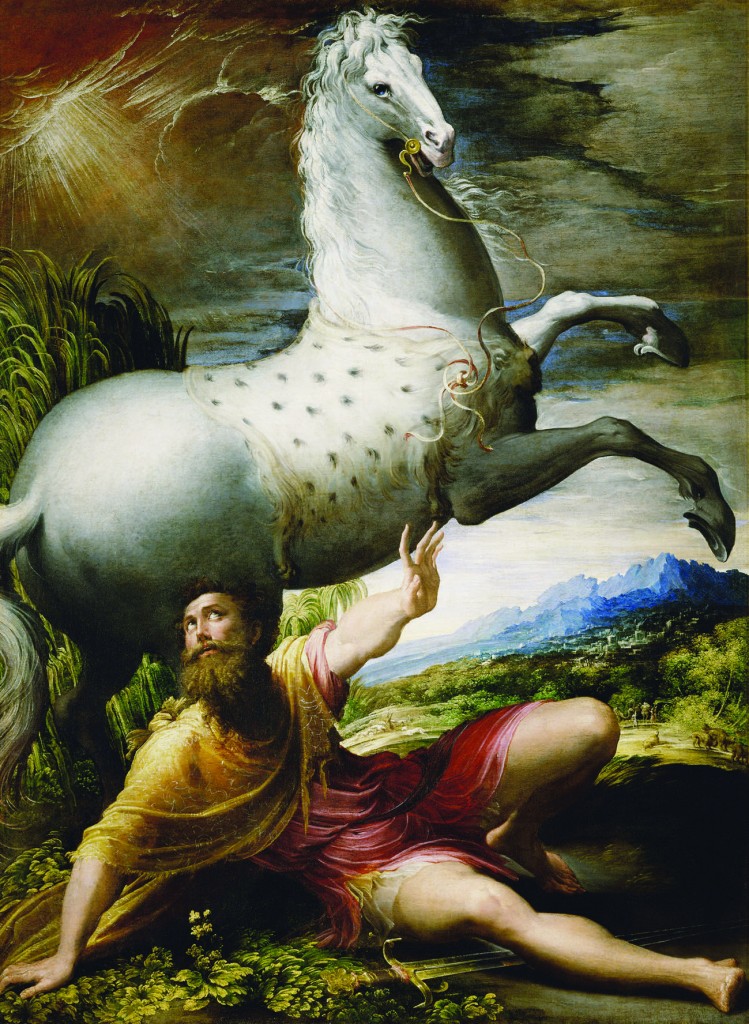
Parmigianino’s “Conversion of St. Paul” in the Kunsthistorisches Meseum, Vienna
Others of his works on display are on loan from Capodimonte in Naples, the Uffizi in Florence, the Musée des Beaux-Arts in Strasbourg, the Galleria Estense in Modena, The Vatican Museums, The Getty Museum in Los Angeles, The Fitzwilliam in Cambridge, England, The Ashmolean in Oxford, England, The Albertina in Vienna, Chatsworth Devonshire Collection, The British Museum, Hampton Court, and Her Majesty Queen Elizabeth II.
The art of Parmigianino, who also worked in Rome and Bologna, is represented by roughly the same number of paintings, but alongside his religious and mythological works, the exhibition focuses on his spectacular portraits. He led a trend in Italy towards three-quarters or full-length figures, previously mostly reserved for royalty.
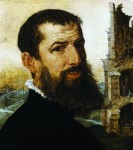
A portrait of Correggio
His paintings on display include his large Bardi Altarpiece, the first work he ever painted at the age of only 16; a monumental St. Roch which he painted for the Basilica of San Petronio, the cathedral in Bologna; The Conversion of St. Paul from the Kunsthistorisches Museum in Vienna; the San Zaccaria Madonna from Florence’s Uffizi Gallery; his so-called Turkish Slave from the Galleria Nazionale in Parma; and his extremely celebrated Antea, one of the most sophisticated and mysterious portraits of the 16th century, from the Capodimonte in Naples, which also loaned his Lucrezia, which, according to Vasari, is Parmigianino’s last painting.
Others of his works on display have been loaned by the Statens Museum for Kunst in Copenhagen, The Ashmolean, The Morgan Library in New York, The Albertina, The Metropolitan, Chatsworth Devonshire Collection, The British Museum, The Galleria Estense in Modena, The Horne Museum in Florence, Rome’s Galleria Borghese, and Her Majesty Queen Elizabeth II.
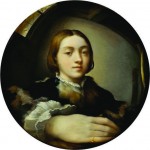
Parmigianino, a self-portrait painted on wood, showing him clean-shaven in a convex mirror
Besides the stars of the show, “Correggio and Parmigianino” also showcases paintings and drawings by less well-known but no less talented artists of the so-called School of Parma: Michelangelo Anselmi, Francesco Maria Rodani, Girolamo Mazzola Bedoli, and Giorgio Gandini del Grano. They illustrate how one of the most remarkable effects of Correggio and Parmigianino’s presence in the city was precisely the emergence of a substantial circle of pupils and followers.
The exhibit’s some 100 artworks — both paintings and drawings — on loan from more than 50 museums and private collectors, most mentioned above, are divided into 10 sections: “Correggio and Parmigianino,” “Young Correggio,” “Young Parmigianino,” “The Artists’ Mature Years,” “Correggio and Parmigianino’s Mythological Works,” “Turkish Princess and a Group Portrait by Bedoli,” “Gandini, Anselmi, and Bedoli,” “Drawings,” “Portraits,” and “Antea, Parma and Alessandro Farnese, Athena, and Lucrezia.”
The first section, “Correggio and Parmigianino,” points out that to understand fully these two artists’ talents it’s necessary to travel to Parma to admire their magnificent frescoes.
Correggio’s first major commission in Parma (February-September 1519), was the ceiling decoration of the private dining salon of the mother-superior (Abbess Giovanna Piacenza) of the convent of St. Paul called the Camera di San Paolo at Parma.
Here he painted an arbor pierced by oculi opening to glimpses of playful cherubs. Below the oculi are lunettes with images of feigned monochromic marble. The fireplace is frescoed with an image of Diana. The iconography of the scheme is complex, combining images of classical marbles with whimsical colorful bambini. While it recalls the secular frescoes of the pleasure palace at the Villa Farnesina in Rome, it is also a strikingly novel form of interior decoration.
The next year, Correggio painted the illusionistic Vision of St. John on Patmos for the dome of the Church of St. John the Evangelist. Three years later he decorated the dome of the Cathedral of Parma with a startling Assumption of the Virgin.
These two works represented a highly novel illusionistic sotto in su treatment of dome decoration that would exert profound influence upon future fresco artists.
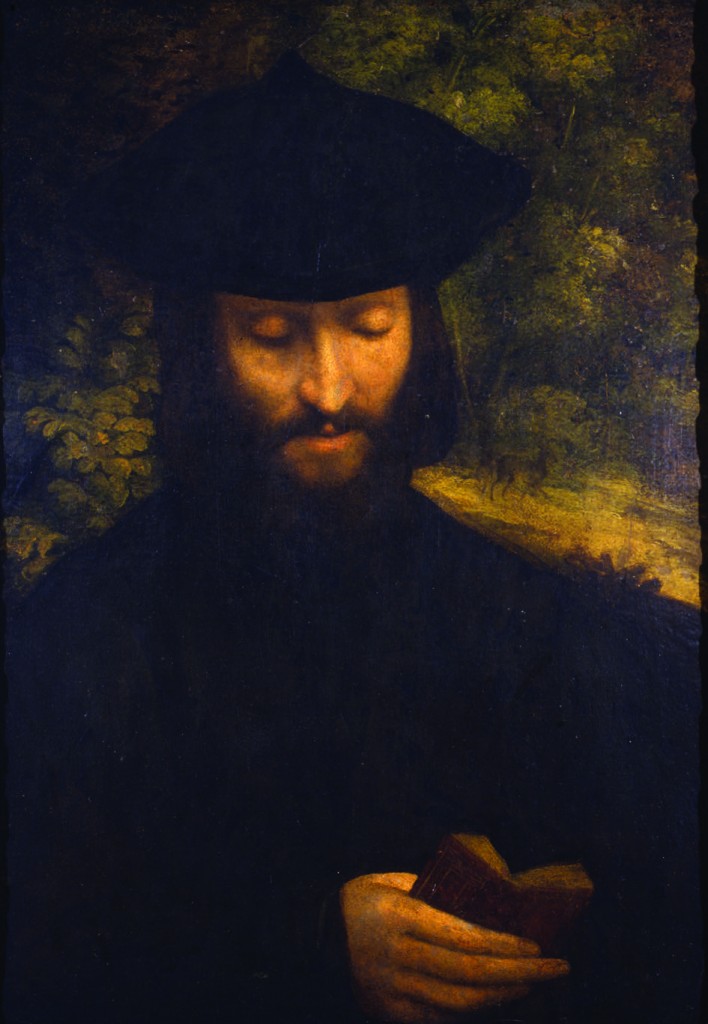
Correggio’s portrait of “A Man with a Book” in Milan’s Castello Sforzesco
Parmigianino is better known for his portable works now, as we have seen, in collections worldwide, but he too frescoed three chapels in the Church of San Giovanni Evangelista before 1520, and then in the last decade of his life, the ceiling of the presbytery of Santa Maria della Steccata. Several of his preparatory drawings for these two projects are in Room 8.
“Correggio and Parmigianino” goes on to explain, compare and contrast the two artists, both of whom died young. Correggio worked for a short time in Mantua, where he was influenced by Mantegna’s work, but then always in Emilia Romagna, whereas, besides in Parma, Parmigianino worked in Bologna and Rome, where Vasari tells us he was “celebrated as a Raphael reborn.”
Although Parmigianino was influenced by Correggio’s art, they had two different personalities and styles. A master of chiaroscuro, Correggio was passionate, vigorous and emotional, full of motion, and splendid in portraying the joy of the Madonna at her motherhood and her immense grief for the death of her Son. His use of dynamic composition, illusionistic perspective and dramatic foreshortening prefigured 18th-century Rococo art.
Melancholy Parmigianino was more detached from his subjects and his style was ever elegant and refined. Both painted religious and mythological subjects (Correggio’s based on episodes of Ovid’s Metamorphoses), but Parmigianino’s talent reached its peak and surpassed Correggio with his portraits.
“Young Correggio” concerns the artist’s work before his arrival in Parma. The earliest of them, The Madonna and Child (“The Barrymore Madonna”) and The Mystic Marriage of St. Catherine with Sts. Francis and Dominic, both from Washington, must date from around 1510-12, and reveal the profound effect of Mantegna, who also deeply influenced Correggio’s first night scene, Judith and Holofernes, painted around the same time, now in Strasbourg.
All three are miniature in size, but only three years later Correggio was painting works of ambitious scale such as his David Before the Ark of the Covenant, only relatively recently rediscovered and in a private collection. It too corresponds to one of a pair of organ shutters commissioned from Correggio on September 8, 1514 for the Benedictine monastery of San Benedetto Po outside Mantua, but is directly dependent upon Mantegna’s canvasses of the Triumph of Caesar still in Mantua. On display here is his Portrait of a Woman, one of the only two portraits he ever painted, now kept in the Hermitage.
On display in “The Young Parmigianino” are the works of a prodigy: The Mystic Marriage of St. Catherine with Sts. John the Evangelist and John the Baptist reveals that, although he is familiar with the work of Correggio, he already has a style of his own in his religious works and in his portraits.
In his biography of Parmigianino, Vasari wrote: “Hearing of the fame of this master, Signor Lorenzo Cybo, Captain of the Papal Guard, had a portrait of himself painted by Francesco, who may be said to have made not a portrait, but a living figure of flesh and blood.” Also in Room 3 are a selection of Parmigianino’s earliest red-pencil drawings.
Yet in spite of their differences, both painters never tired of developing and improving their work. The layout of the exhibition aims to follow their respective changes over time, not only in their styles, but also in their choice of subject matter.
“The Artists’ Mature Years: 1520s-30s,” when both were working in Parma, includes Correggio’s Noli Me Tangere with its enchanting background landscape, and his Martyrdom of Saints Placido, Flavia Eutichius and Vittorinus, seemingly influenced by Bernini’s statue of Santa Teresa in Ecstasy as well as the realism of Parmigianino’s The Madonna and Child with St. Zachary, who is depicted complete with a hairy wart on the cheek, and his Conversion of St. Paul with its richly detailed background landscape.
It seems that Parmigianino assumed he was to be Correggio’s disciple and to continue his work in the apse and choir of the Parma Cathedral. Sadly, his newly-found obsession with alchemy drained all his energy, leaving him little time to paint. Parmigianino was even imprisoned for two months for breach of contract, and died a poor man in disgrace.

Parmigianino’s portrait “A Man with a Book” in the York Art Gallery in England
During the Renaissance, the vast majority of art depicted religious subjects. Both Correggio’s and Parmigianino’s first mythological subjects were frescoes from the early years. All their mythological subjects on canvas, however, date to their mature years (Room 5).
It’s fair to say that, in the second half of the exhibit, the talent of Parmigianino and of Gandini, Anselmi, and Bedoli as drawers outshines that of Correggio. In spite of his love for the red pencil, Correggio just cannot compete with Parmigianino, who was a born draughtsman and a hugely prolific and spontaneous one. He was equally good at penmanship and watercolors. Like many other Renaissance artists, Parmigianino used the pen to draw his subject and the pencil to refine and complete it.
The exhibit’s sixth room, “The Turkish Girl,” its ninth’s “Portraits,” and its tenth and last’s “Antea, Parma, and Alessandro Farnese, Athena and Lucrezia” primarily concern Parmigianino’s “portraits.”
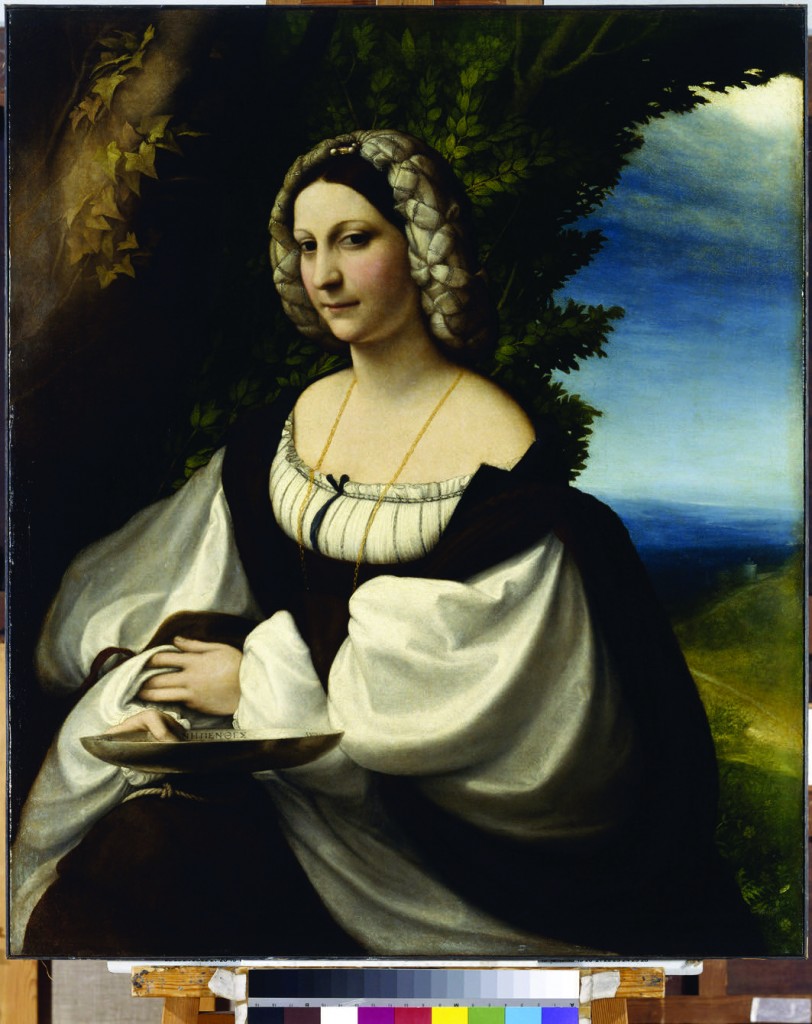
Correggio’s “Portrait of a Lady” in the Hermitage
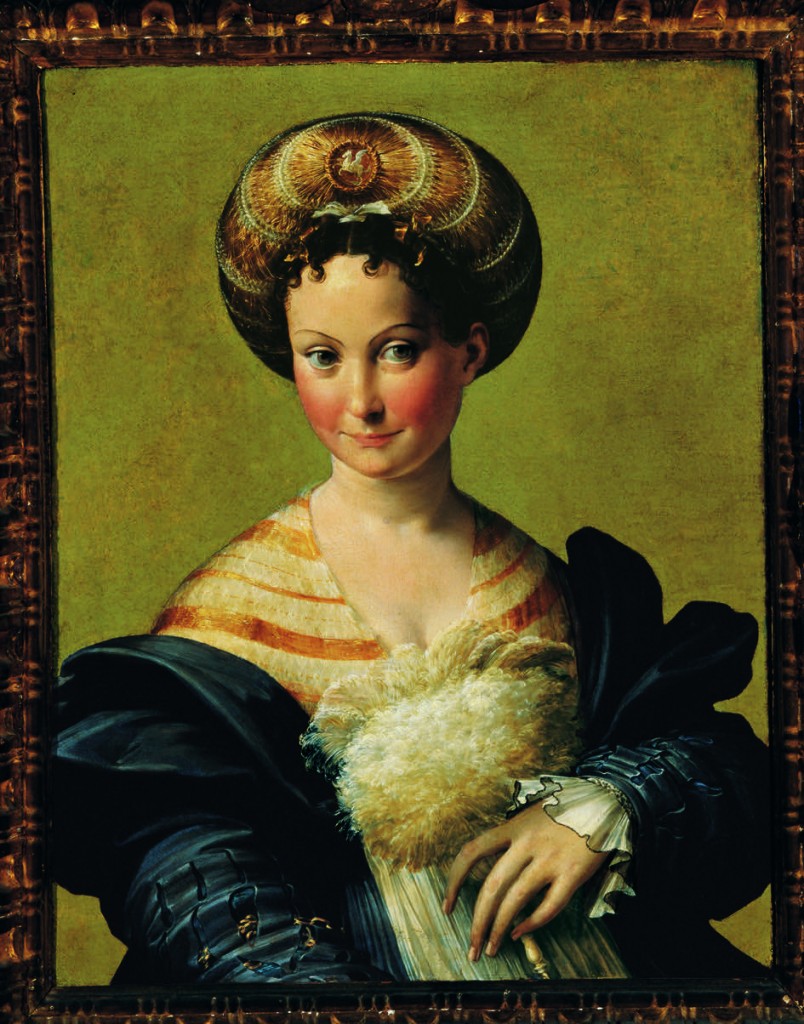
Parmigiano’s “Turkish Slave” in Parma’s State Art Gallery in Italy
His portraits in Room 9 are both of men. One depicts a bearded man wearing a hat and holding a book. It includes background furniture and a Persian rug and dates to the artist’s first stay in Rome in 1524. The second also dates to the Roman period, and concentrates on the human figure dressed in black and white against a grey wall. The only color is the man’s pink flesh. In contrast, many of the brightly lit faces and long necks of Parmigianino’s elegantly dressed female “portraits” are idealizations, stylizations. For example, nobody knows the true identity of Antea. Like the men on display, she was painted during his Roman period. She’s been identified as Parmigianino’s daughter, lover, servant, or a local noblewoman. Although Parmigianino used her face again for one of the angels in his much later unfinished work, The Madonna of the Long Neck (1535-40), her true identity, like the “Mona Lisa,” remains a mystery.
Parmigianino never gave this canvas a title. It was only given a name a century after his death. Therefore she most likely represents ideal beauty, which was a popular genre of portraiture during the Renaissance. In such portraits, the beauty and virtue of the woman were the primary subjects, while the sitter’s identity—and even her existence—were of secondary importance.
This is also true of his Turkish Slave (1533), painted when he was back in Parma and who is neither Turkish nor a slave. She mistakenly gets her name because of her turban, which was in fact a typical headdress of noblewomen of the time with examples in numerous portraits. Sadly missing here are Parmigianino’s two self-portraits.
One, painted on wood, showing him clean-shaven in a convex mirror, is now in the Kunsthistorisches Museum and dates to 1524. The other shows him bearded, disheveled, and wearing a red hat, and dates to 1540, the year of his death.

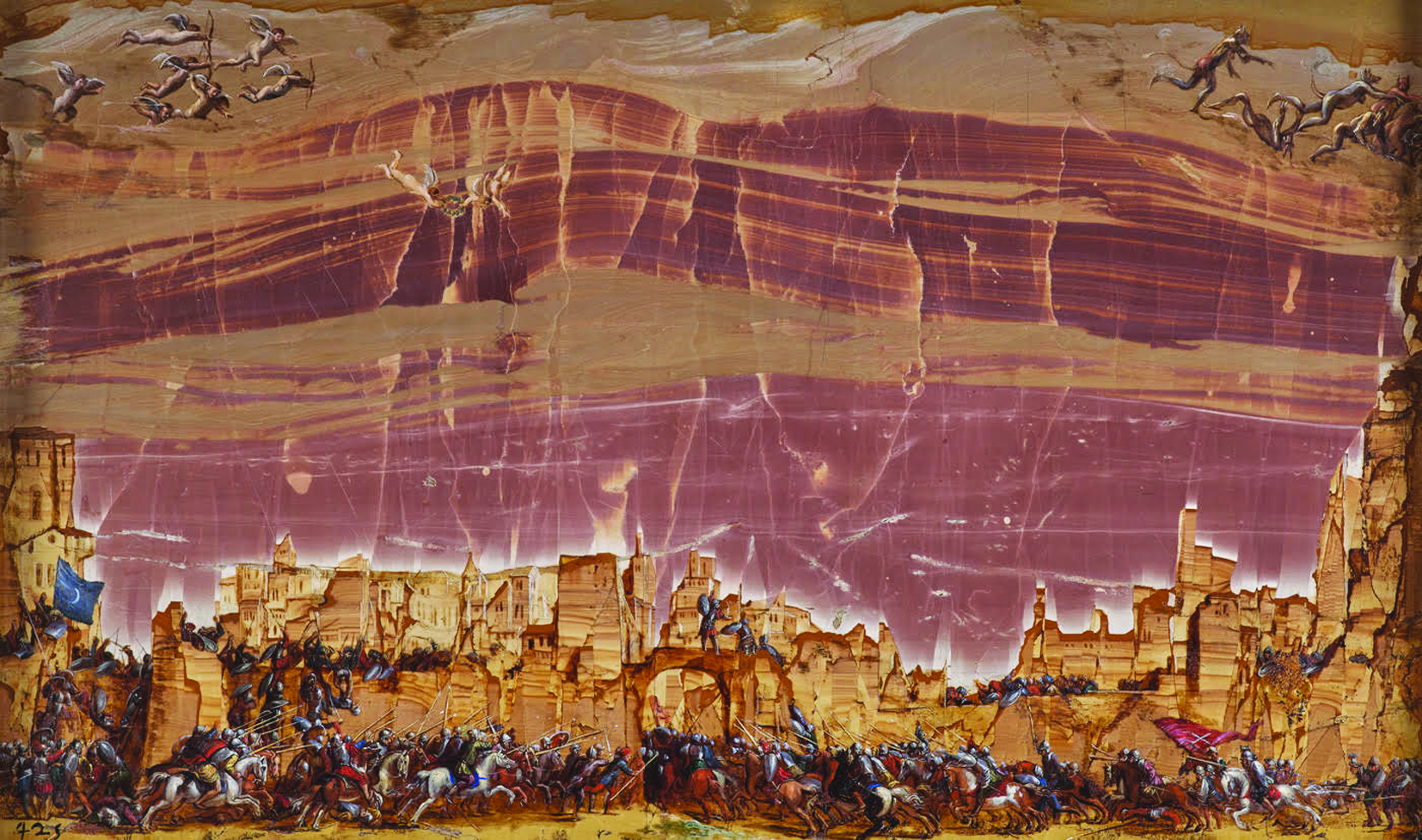
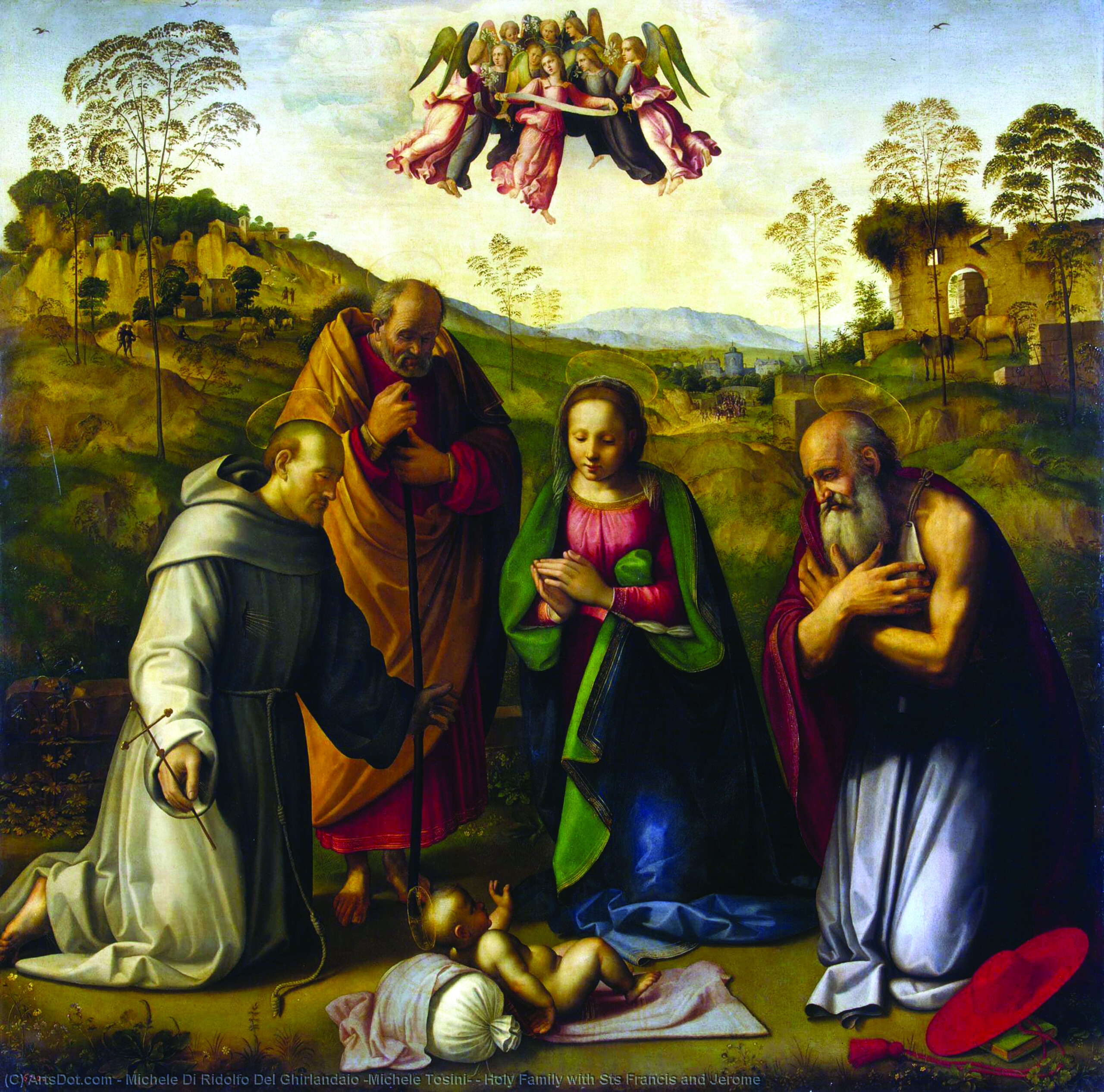
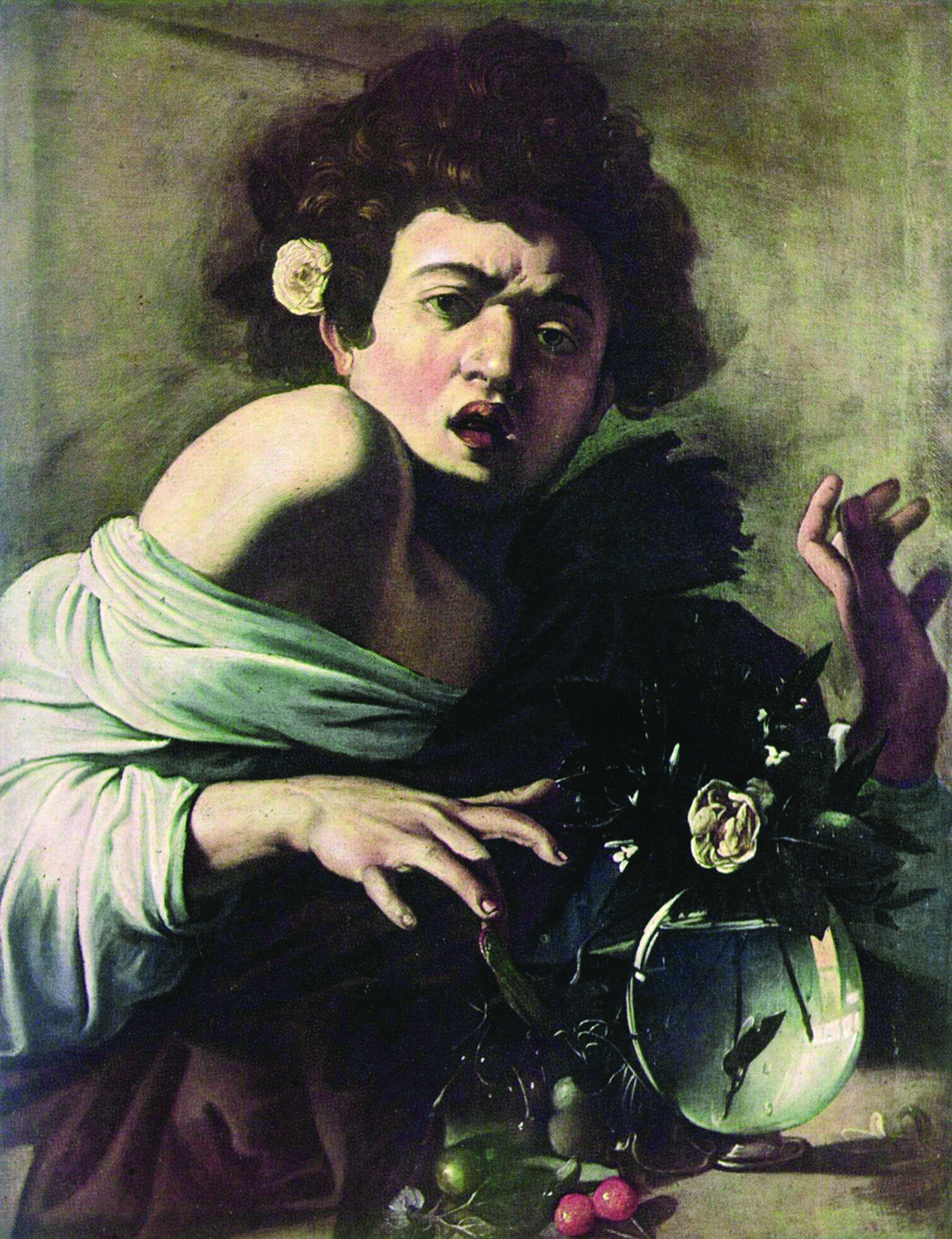
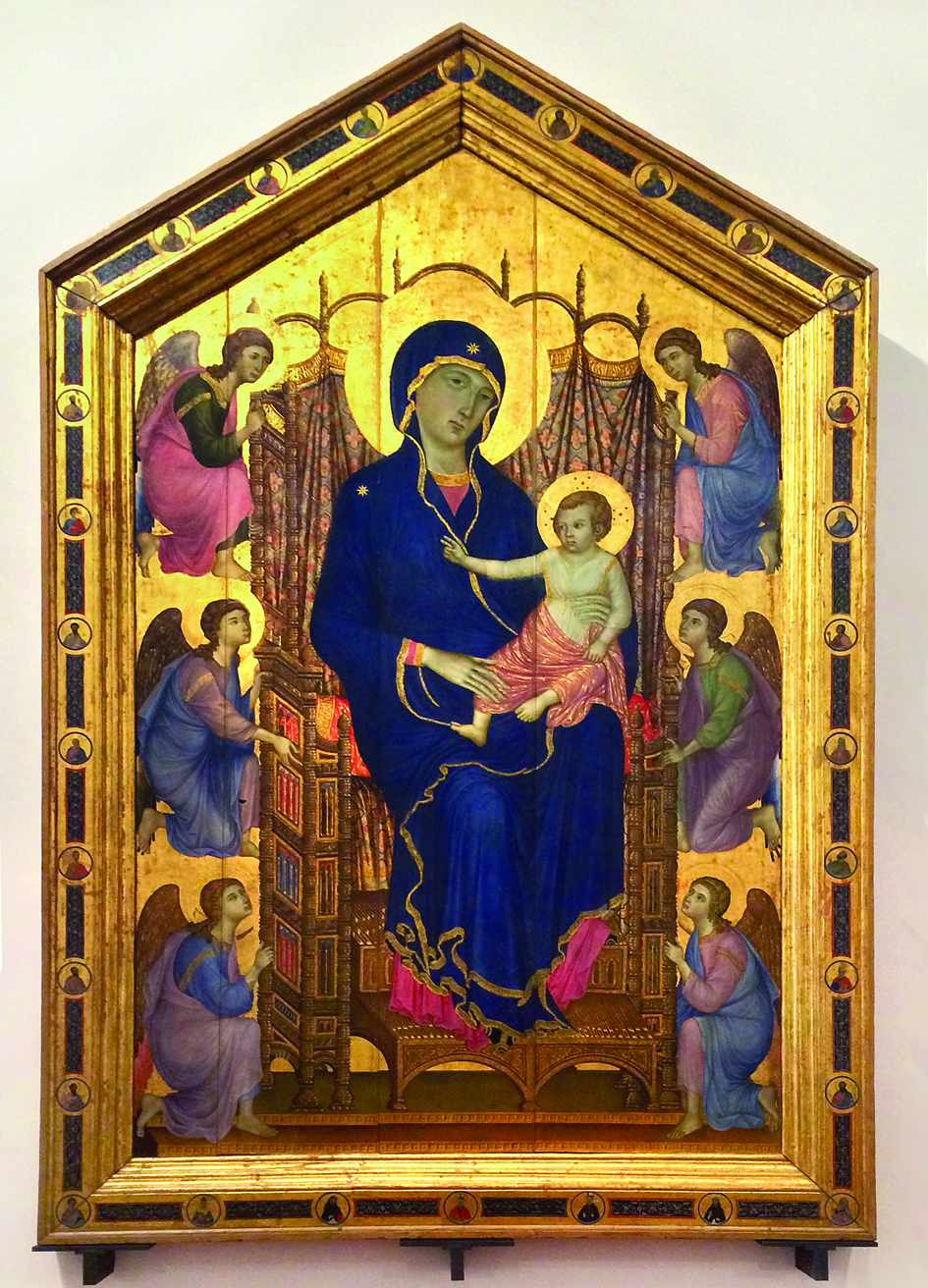

Facebook Comments